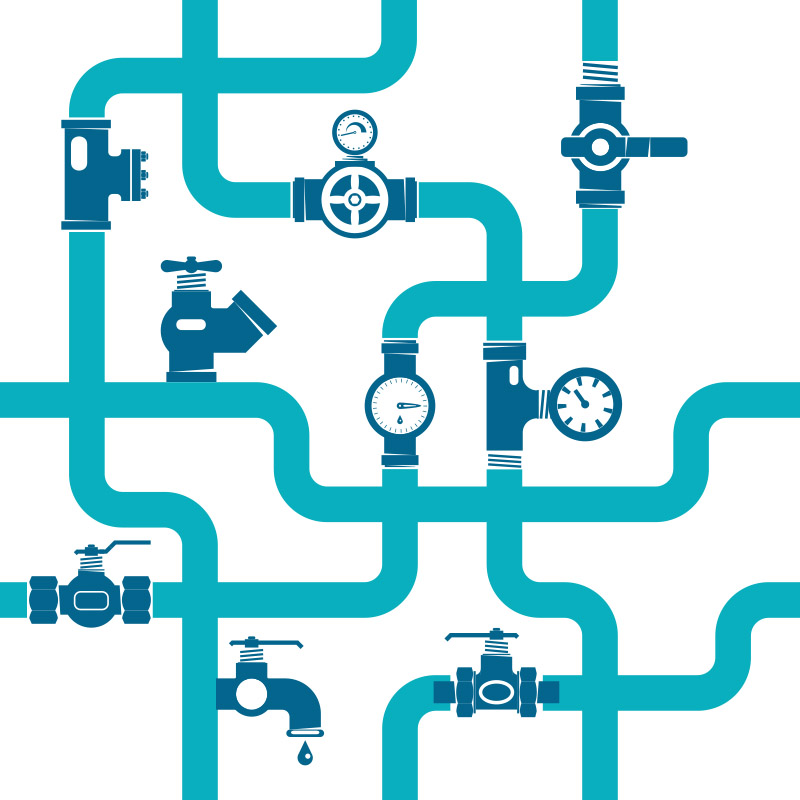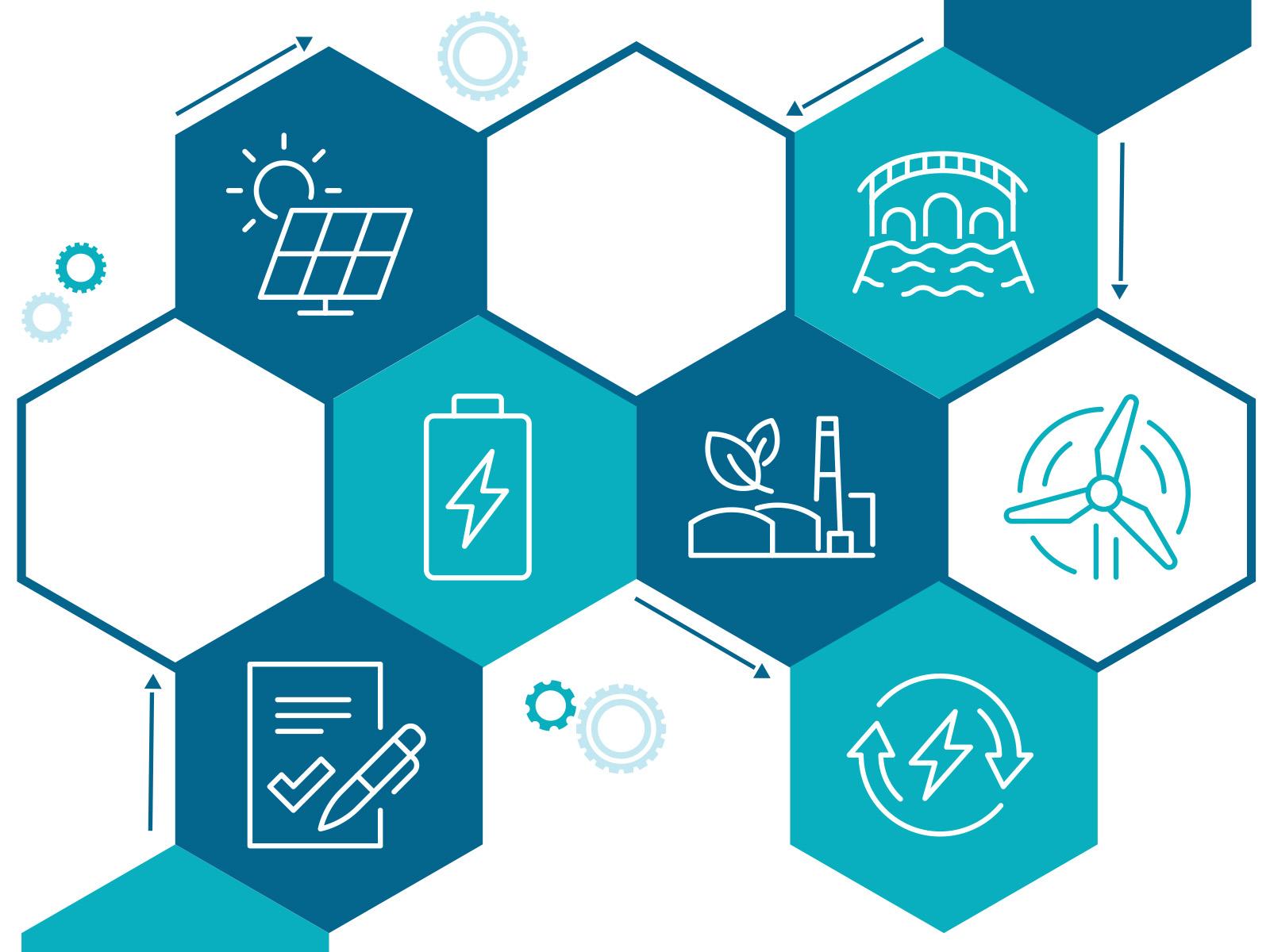Energy Resilience
Identifying potential energy resilience options

Reliable energy is paramount for uninterrupted water system operations. Integrating renewable energy technologies, where appropriate, can reduce costs and operations-related emissions while protecting against power disruptions.
The suitability of a particular renewable energy technology depends on factors like site characteristics, upfront and operating costs, and the duration and timing of energy needs during an outage event. Below, we provide some resources to aid in researching the technologies that may best fit your specific requirements and provide background information on energy storage, permitting, interconnection requirements, and power sales.
Learn more
Utility Interconnection and Sales

Solar
Do you have more than 500–1,000 square feet of open, available unshaded roof or land at the site? If so, solar may be an option for generating renewable energy as part of a resilient backup-power system.
Solar photovoltaics (PV) generate electrical energy by absorbing energy from sunlight and converting it through semiconducting materials into electricity. Due to their modular nature, PV systems can be built to meet small or large power needs in both grid-connected and off-grid configurations.
For more information about solar PV, please refer to the following resources:
- Department of Energy Solar Energy Resources
- Solar policies and incentives - Database of State Incentives for Renewables and Efficiency (DSIRE)
- Solar resource assessment maps
- Solar supply curves (includes resource assessment and data on siting regulations)
Key factors for solar suitability
- Available unshaded roof or land area (500–1,000+ sq ft)
- High solar irradiance levels for the location
- Flat terrain with minimal slope (<5 degrees)
- Proximity to grid interconnection points
- Local climate conducive to solar exposure
- Compliance with land use policies and zoning
- Minimal shading from surrounding obstructions
Conduit hydropower
Under normal operating conditions, do you actively reduce water pressure at the site with one or more pressure reduction valves (PRVs)? Are any PRVs located in a space where there is room to add additional equipment? If so, it could be possible to add a hydropower turbine in parallel with a PRV to generate electricity while maintaining the required pressure reduction.
Conduit hydropower uses existing pipelines, canals, and other human-made infrastructure to generate electricity by capturing the flow and pressure of water and converting into electricity. Most hydropower projects require permitting through the Federal Energy Regulatory Commission, but hydropower within existing water systems often fits the fastest/easiest permitting pathway for “Qualifying Conduit Hydropower Facilities.”
For more information about conduit hydropower, please refer to the following resources:
- Department of Energy Hydropower Permitting Resources
- California Energy Commission Conduit Hydropower Development Guidebook
- National Conduit Resource Assessment conducted by Oak Ridge National Laboratory
- Hydropower policies and incentives - Database of State Incentives for Renewables and Efficiency (DSIRE)
Key factors for conduit hydropower sites
- High-pressure differentials
- High continuous water flows
- Proximity to power lines for interconnection
- Can utilize existing infrastructure (vaults, piping, valves) to reduce costs
Wind energy
Is the site in a consistently high-wind area—for example, when you arrive at the site, must you take care in opening a car door because of the wind? Does the site have approximately one acre or more of available, treeless, open land outside of any protected areas, such as parks? If so, a wind energy installation could be worth exploring.
Wind turbines capture the kinetic energy of wind. The rotation of wind turbine blades is transferred to a shaft that is connected to a generator, producing electricity. Wind turbine sizes can vary, as can their interconnection to the grid—they can be built on the distribution grid to serve local loads or connected to the transmission system as utility-scale systems.
For more information about wind energy, please refer to the following resources:
- Department of Energy Wind Resources
- Wind energy policies and incentives - Database of State Incentives for Renewables and Efficiency (DSIRE)
- Wind resource and maps from the National Renewable Energy Laboratory
Key factors for wind potential
- Consistently high wind speeds at the site location
- Approximately one acre or more of available, treeless, open land
- Site is outside of protected areas like parks
- Local zoning and permitting regulations allow wind projects
Biogas
Do you flare methane at the site (such as might be produced from anaerobic digestion processes at a wastewater treatment plant)? If so, it might be possible to use the methane to power a generator.
Anaerobic digesters convert organic wastes into biomethane and other byproducts. Biomethane, also known as biogas, can be produced from a wide range of organic wastes, and the biogas can be used on site to produce energy or be refined into renewable natural gas for pipeline injection.
For more information about biogas, please refer to the following resources:
- Department of Energy Bioenergy Resources
- Anaerobic digestion policies and incentives - Database of State Incentives for Renewables and Efficiency (DSIRE)
- EPA Biogas Toolkit
- EPA Anaerobic Digestion Screening Tool, Version 2.2
- EPA Risk Analysis Checklist for Biogas Projects
- American Biogas Council RIN Calculator
Energy storage
Energy storage refers to the process of capturing and storing energy for later use. One prominent example of energy storage technology is lithium-ion batteries. These batteries use lithium ions to store and release electrical energy, making them a popular choice for various applications, including portable electronics, electric vehicles, and grid-scale energy storage.
By integrating energy storage with renewable energy sources, sites can reduce greenhouse gas emissions and reliance on fossil fuels while maintaining a consistent power supply, enhancing energy security and grid reliability.
For more information about energy storage, please refer to the following resources:
- Department of Energy On-Site Energy Storage Decision Guide
- Renewables and storage integration decision support tool
- Energy Storage Procurement Guidance Documents for Municipalities
- Resilient Power Project Toolkit
Key factors for lithium-ion battery energy resilience
- Properly size the battery system to support critical loads for extended outages
- Maintain compatibility with existing facility infrastructure for seamless integration
- Integration with on-site renewable energy like solar or biogas for enhanced resilience and sustainability
- Develop comprehensive maintenance and replacement planning to assure long-term reliability
Permitting
A crucial part of any power generation project is obtaining the necessary permits from local, state, and federal agencies. State, county, or municipal codes may require additional permits issued by a local government (e.g., city or county) before construction or operation. Work with your local planning agency to determine which permits apply to your situation.
Utility Interconnection and Power Sales
Interconnection
In most cases, a connection to the utility grid will be required and all renewable energy projects that connect to the electric grid must work through an interconnection process with the local utility. This process verifies technical compatibility, safety, and compliance with regulations and power standards such as IEEE 1547-2003, UL1741, and the National Electric Code. Contact your local power company for more information.
Power Sales
Projects often have two options to sell or get credit for the power they generate: Net Metering, or power sales as a Qualifying Facility. Other options may be available in your area, check with your utility to learn more.
Net metering, where offered, is a billing arrangement where a renewable energy system offsets the electricity consumption at a site, often on a monthly or annual basis. Typically, the utility credits the system owner for any excess energy produced, which is sent back to the grid and can be used to offset future electricity bills. Net metering is commonly used for small-scale installations like residential solar panels but may also be available for other technologies, subject to utility or state limitations. Check with your utility to see if net metering is an option.
Where net metering isn’t an option, or where a project’s electrical capacity exceeds net metering limits, energy can be sold to the utility through a Qualifying Facility (QF) designation under the Public Utility Regulatory Policies Act (PURPA). PURPA allows QFs to sell their electricity to utilities at negotiated rates, and utilities are required to purchase this energy. QFs must meet specific capacity and regulatory requirements to qualify for this arrangement, and the rates are usually based on the utility’s avoided cost. Selling power as a QF requires a more complex contractual relationship with the utility, including the potential for penalties if contractual obligations aren’t met. As such, this power sales pathway is more commonly used by large-scale renewable energy projects operated by independent power producers.